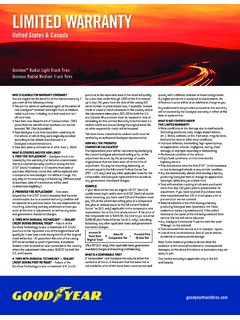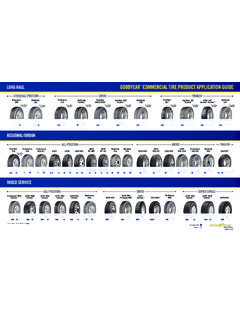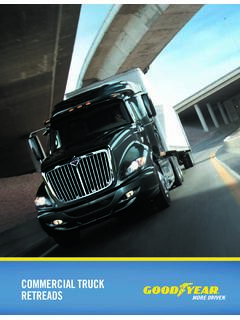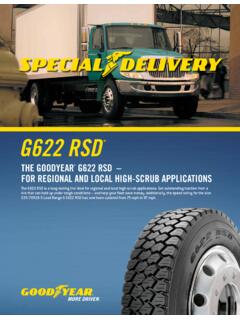Transcription of TIRE CASING RETREAD AND REPAIR MANUAL FOR ECDII …
1 GOODYEAR COMMERCIAL TIRE SYSTEMSTIRE CASING RETREAD AND REPAIR MANUALFOR ECDII AND DURASEAL TECHNOLOGY 16/23/08 2:07:25 PM6/23/08 2:07:25 PMIntroduction .. Page 2 Enhanced CASING Design (ECD) ECD vs. ECDII .. Page 3 Buffing ECDII Casings .. Page 4 DuraSeal Technology .. Page 5 Tire Inspection .. Pages 6-7 Permanent Puncture Repairs .. Pages 7-9 Tire Section Repairs .. Page 9 Tire Curing .. Page 10 Final Inspection .. Page 10 TABLE OF 26/23/08 2:07:38 PM6/23/08 2:07:38 PM2 INTRODUCTIONG oodyear commercial truck tires feature cutting-edge technology accumulated through almost a century of experience in the trucking industry. Two of our CASING innovations include ECDII and DuraSeal Technology. This Tire CASING RETREAD And REPAIR MANUAL For ECDII And DuraSeal Technology gives an overview of ECDII and DuraSeal Technology. Most importantly, it covers the specific RETREAD and REPAIR procedures and standards for casings with ECDII and DuraSeal Technology.
2 ECDII and DuraSeal Technology help keep your fleet up-and-running, and give you excellent performance and value. Please make sure you read this MANUAL , learn from it and follow the guidelines for retreading and repairing casings with ECDII and DuraSeal Technology. It can help you get the most out of your Goodyear commercial truck 16/23/08 2:07:38 PM6/23/08 2:07:38 PM3 ECD VS. ECDIIENHANCED CASING DESIGNMany Goodyear commercial truck tires are made with ECD. It features a polyamide belt package to help promote puncture resistance, retreadability and toughness. Since ECD has had a very successful track record, Goodyear will continue to use it in select products. ENHANCED CASING DESIGN IIECDII has additional features. In place of the polyamide belt package, the ECDII features a four (4) steel belt package. The steel belt cord has enhanced rubber penetration and optimized cord spacing.
3 These two enhancements, combined with a tough belt compound , enhance CASING life and retreadability to help deliver strong, outstanding performance. ECDII 26/23/08 2:07:38 PM6/23/08 2:07:38 PM4 BUFFING ECDII CASINGSECDII casings contain four (4) steel belts. There is no top polyamide fabric breaker in ECDII casings as in ECD casings. Buffing equipment, which employs a belt detection system, has to be adjusted when buffing ECD casings to ensure proper gauge above the top steel belt without destroying the ECD polyamide fabric ECDII CASING contains a four (4) steel belt package. There is no polyamide fabric breaker. As a result, the ECDII CASING should be buffed the same as any standard four (4) steel belt BUFFING AN ECDII CASING , NO ADJUSTMENT OF THE AUTOMATIC BELT DETECTION SYSTEM IS REQUIRED TO OBTAIN THE PROPER GAUGE ABOVE THE STEEL TOP 36/23/08 2:07:39 PM6/23/08 2:07:39 PM5 ABOUT DURASEAL TECHNOLOGYDuraSeal Technology is the world s first built-in tire sealant for commercial truck tires.
4 Built into the crown of the tire, DuraSeal Technology is a yellow, gel-like rubber compound that can seal a 1/4-inch tread puncture while the tire is in service to avoid vehicle downtime. It also helps minimize the chance of chamber fires and the likeliness of liner surface contamination because there are no liquid sealants applied to the inside of the CASING after up to 1/4-inch punctures only in the repairable area of the tread. Does not seal sidewall TECHNOLOGY 46/23/08 2:07:42 PM6/23/08 2:07:42 PM6 TIRE INSPECTIONThe appearance of the liner in casings with DuraSeal Technology may be different than standard casings. The liner may be loose and look separated in the crown area (Figure 1). Normally, the liner is tight to the CASING from the bead to the upper DuraSeal Technology compound , while not liquid, is fluid enough to move or migrate in service. When filling a puncture, the compound may migrate out of the liner and, in some cases, may even be visible on the outside of the tire.
5 There may be areas of the liner where the compound has moved and will create a depression. Other areas may have an accumulation of sealant material and exhibit lumps or thick spots (Figure 2). This is considered normal. The compound will spread out evenly when the tire is in the most difficult waste haul applications, casings may accumulate high numbers of metal pieces (nails, screws, miscellaneous debris, etc.) in the tread area (Figure 3). This is due to the success of the DuraSeal Technology at sealing punctures. Because of this, tires do not need to be removed from service as often or as early in the tire s service life, allowing the tire to continue to accumulate debris. When the tire is being repaired, this may lead to longer than normal time required to detect and remove metal debris and investigate the need for permanent repairs (Figure 4).Figure 1 Figure 4 Figure 3 Figure 56/23/08 2:07:43 PM6/23/08 2:07:43 PM7 Casings with DuraSeal Technology that have been stored outdoors need to be inspected for signs of water in the CASING .
6 Because the liner does not adhere tightly to the CASING in the tread crown area, it is possible for water to become entrapped between the liner and the body of the CASING . Clear liquid running out of a puncture in the liner (Figure 5) will indicate water in the liner. The existence of water in the CASING will prevent the CASING from being through the liner which are detected by the NDT II electronic inspection machine, or have the penetrating object still protruding through the liner, should be repaired drilled, filled and sealed when puncture injury limits are not exceeded. Punctures may be repaired using standard puncture REPAIR procedures as long as extra care and attention to detail are provided. It is important that the mounted inflated tire assembly is inspected prior to sending the CASING to retreading. Any visible nails and/or puncturing objects in the tread area need to be pulled out at this time to help ensure the DuraSeal Technology compound will seal the example, assume 10 nails were pulled out of the mounted, inflated assembly prior to sending to A tire with DuraSeal Technology comes out of service because it is worn out and the CASING makes its way to the RETREAD plant.
7 It is important that the mounted inflated tire assembly is inspected prior to sending the CASING to retreading. Any visible nails and/or puncturing objects in the tread area need to be pulled out at this time to help ensure the DuraSeal Technology compound will seal the The inspector must inspect the CASING using the NDT II electronic inspection If the NDT II electronic inspection machine shows no issues, then the 10 nail holes do not need to be repaired with a patch/plug. But IF the NDT II electronic inspection machine, for example, shows that two of the holes do not pass inspection, then only those two holes require 5 TIRE INSPECTIONPERMANENT PUNCTURE REPAIRSDURASEAL TECHNOLOGY (CONT.) 66/23/08 2:07:47 PM6/23/08 2:07:47 PM8 The following steps need to be taken when repairing tread area punctures in casings with DuraSeal Technology:1. Penetrations through the liner that no longer have the penetrating object in place may be hard to detect on the inside of the tire.
8 While it is preferred to drill and clean the injury from the inside out, it may be necessary to drill the injury from the outside in. Use an awl to determine the direction of the injury, and use care to drill as closely to the injury path as Inspect the carbide cutter used to drill out the injury for possible contamination from the DuraSeal Technology If buffing tools (rasps, carbide cutters, ball burrs) become contaminated with the compound , they must be cleaned before being used again. A hand-held wire brush is recommended to clean the tools. The use of pre-buff cleaner or another approved solvent can be applied to loosen the contaminant if necessary. A clean, lint-free shop cloth or wire brush should be used to remove the contaminating If the liner appears to be loose at the point of injury, press by hand or stitch the liner down to minimize any Carefully prepare the liner area with pre-buff cleaner and a scraper as Carefully buff the liner without excessive pressure.
9 However, all bladder vent patterns must be removed (Figure 6). An alternate option to using a tungsten carbide rasp to buff the liner is to use a soft wire brush to achieve a RMA #1 texture and lessen the chance of tearing the If the liner is loose or torn, the liner should be cut out with a sharp Any exposed yellow DuraSeal Technology compound will have to be removed. If all exposed compound cannot be totally removed, any excess material may be pushed back under the adjacent liner using an PUNCTURE REPAIRS (CONT.)Figure 76/23/08 2:07:47 PM6/23/08 2:07:47 PM99. The injury channel and any void caused by removing the liner must be filled with extruded rope rubber or cushion gum. The void area created by the removal of liner material must be cemented with a Nylobond brush type cement and filled with cushion gum or extruded rope rubber after the cement is dry. Fill the injury from the inside of the tire.
10 This will avoid excess rope rubber from being pushed under the liner. The fill rubber in the injury and void liner area should adhere to the CASING and the REPAIR unit after curing to help anchor the REPAIR in Use of a ball burr on the liner at the injury to check for splits may be difficult if the liner is loose. If using a ball burr, extreme care should be taken not to tear the liner and create a more difficult REPAIR . An awl may be used to probe and detect radial PUNCTURE REPAIRS (CONT.)DURASEAL TECHNOLOGY (CONT.)Tire section repairs where the injury is in the sidewall should not result in any additional difficulty (Figures 7 and 8). Care must be taken when buffing the liner in the sealant area since it may not be firmly attached to the CASING . DuraSeal Technology compound does not extend beyond the belt edge/shoulder area, so it will not affect preparation on the sidewall section to be repaired.










